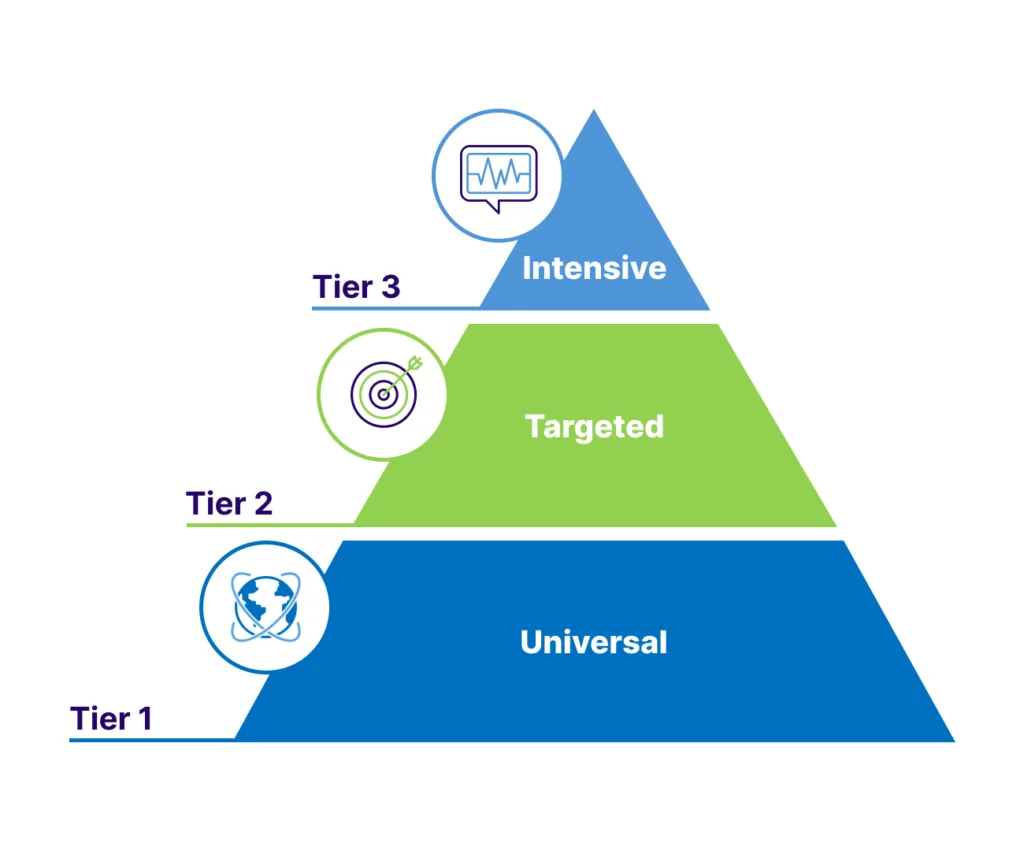When people hear ‘behavior’ in MTSS, they often think of discipline or misbehavior -but, it’s so much more than that. MTSS-B focuses on proactively supporting students’ social-emotional and behavioral (SEB) needs through a structured, tiered system.
The Multi-Tiered System of Support (MTSS) is a three-tiered framework designed to meet the diverse needs of all students with high-quality, evidence-based practices. While MTSS is often divided into MTSS-A (academic) and MTSS-B (behavior), it’s important to remember that the meaning of MTSS-B is to address the full spectrum of SEB needs. Since academic and behavioral needs are closely connected, a whole-child approach is essential for effective support, and to do that, school teams need to understand the MTSS-B framework.
MTSS Overview
In order to understand behavior in the context of the MTSS framework, a general understanding of MTSS is necessary. MTSS uses 3 tiers – Tier 1, universal supports, Tier 2, Targeted Supports, and Tier 3, Intensive Supports, to address the needs of all students.

Check out our recent blog article for a better understanding of how the Tiered supports address student needs at all levels. The MTSS-B framework is designed to actively support the five core social-emotional learning competencies identified by CASEL: self-awareness, self-management, responsible decision-making, relationship skills, and social awareness. It helps students build strong emotional and social foundations while enhancing support for skill development at each tier. Through this tiered system, schools can provide the right level of instruction, intervention, and support to meet students’ SEL and behavioral needs in a meaningful and sustainable way.
Knowing the MTSS-B framework is a great start—but it’s just one piece of the puzzle. To really make it work in your organization, you’ll also need a solid handle on the support in place, how your teams are structured, what your referral pathways look like, how you’re collecting data, and how you’re checking for fidelity. These are the moving parts that bring the whole system to life.
MTSS-B System Support Considerations
Tier 1: Universal Strategies – Token Tower Case Study
Many schools use Positive Behavior Interventions and Supports (PBIS) as part of their Tier 1 strategy to foster positive behavior, social-emotional development, academic success, and a supportive school climate. But effective implementation requires more than good intentions—it needs structure and a dedicated team.
Consider two schools, Panther Elementary and Bear Elementary, both launching a token tower PBIS system. The idea: students earn tokens for meeting school expectations (Safe, Respectful, Responsible) and vote for a school-wide reward like a popcorn party or pajama day.
At Panther Elementary, the system is consistent and intentional. Students turn in tokens at the front office, where they’re greeted warmly, get a “Panther Pride” stamp, and explain what they did to earn the token. They also sign a book that helps track engagement and identify students needing more support. Every adult in the office is trained and involved, creating shared ownership and a positive school culture.
At Bear Elementary, the same system lacked structure. Students dropped off tokens without interaction or recognition, leading to less motivation and missed opportunities to reinforce positive behavior. Without meaningful connection, the impact of the system weakened.
This case study highlights the importance of well-structured Tier 1 support. When done right, they not only promote a positive climate but also help schools identify students needing additional support early, allowing MTSS-B teams to intervene effectively and keep all students on a path to success.
Once your Tier 1 supports are solid and consistently implemented, you’ve laid the groundwork for schoolwide success. Still, it’s important to recognize that some students will need more than universal strategies. That’s where Tier 2 steps in—offering targeted, small-group interventions designed to support those who need an extra boost to stay on track.
Tier 2: Targeted Support – Plug and Play
Understanding the supports available at Tier 2 is essential for running an efficient and responsive system. Factors like staffing, building capacity, and training can impact which interventions are feasible—but with a little creative problem-solving and some ready-to-use strategies, many of these challenges can be overcome.
At Tier 2, considering the function of a student’s behavior isn’t just helpful—it’s necessary to effectively meet their needs. This can feel overwhelming for teams without a plug-and-play system in place. Behavior Advantage’s List of 20 Essential Intervention Strategies is a great starting point for school teams. It’s designed to help you quickly implement interventions that align with the function of behavior and provide immediate support to students. As schools build confidence and consistency in their MTSS-B Tier 2 interventions and support, they can be more clear about students who need Tier 3, intensive interventions, and potentially reduce special education referrals.
Tier 3: Intensive Interventions – Increased Support
Tier 3 MTSS-B support can feel complex at first—often leaving teams wondering,“What more can we do?” A good place to start is by increasing the time, intensity, and frequency of the function-based supports already in place. For instance, if a student is participating in a Tier 2 Check-In/Check-Out system, the team might add more frequent check-ins with trusted adults throughout the day to provide additional connection and support.
Tier 3 is also when it becomes appropriate to consider conducting a Functional Behavior Assessment (FBA) and developing a Behavior Intervention Plan (BIP) that’s tailored to the student’s specific needs. Behavior Advantage’s comprehensive guide can get your team off to a great start on writing effective Behavior Intervention Plan (BIP)s No matter the next step, it’s essential that the team understands not just what the intervention is, but also the level of support and coordination required to implement it effectively.
With the understanding of the supports required at each Tier of your MTSS-B system, your MTSS-B team can provide guidance and structure at all three tiers for student support.
The Role of the MTSS-B Team in Supporting Student Behavior
An essential part of behavior support within the MTSS framework is a strong MTSS-B team. This team provides the structure, evidence-based practices, and relationship-focused strategies needed to reduce behavioral incidents and promote positive school climates.
 A team-based approach ensures behavior supports are implemented consistently, grounded in data, and viewed through a function-based lens across all tiers.
A team-based approach ensures behavior supports are implemented consistently, grounded in data, and viewed through a function-based lens across all tiers.
Core Responsibilities of the MTSS-B Team:
- Data Review: Regularly analyze behavior data (ODRs, incidents, attendance) to identify trends, track progress, and guide proactive decisions.
- Focuses on Function: Ensure behavior is understood by its underlying purpose to select appropriate, effective interventions.
- Support Planning: Develop and adjust individualized behavior plans using data, teacher input and family perspectives.
- Collaborative Communication: Facilitate consistent communication among staff, families, specialists, and school leaders to align support across settings.
- Staff Capacity Building: Provide training, coaching, and just-in-time support to grow staff confidence in using evidence-based, culturally responsive practices.
To dive deeper into building an effective MTSS-B team, read our recent blog post on Building an Effective MTSS-B Team.
Now that you have a solid understanding of how the MTSS-B team supports behavior at the building level, it’s important to know what steps teachers can take when they’ve tried everything they can in the classroom. When more support is needed, there should be a clear process for reaching out—and that starts with the referral system.
From Classroom to Team: A Streamlined Referral Process
When a student isn’t responding to the Tier 1 universal support already in place at the school and classroom level—and strategies like PLC discussions and team problem-solving have been fully explored—it’s time to take the next step. At that point, a referral to the MTSS-B team or committee should be made to get additional support for the student’s behavior.
Behavior Advantage has a free, comprehensive MTSS Referral Form to support teams in establishing a systematic referral process as part of their MTSS-B framework. Whether you use the Behavior Advantage form or one provided by your school or district, consistent use is one of the most important factors for success. That consistency keeps the team focused on finding solutions, helps clarify next steps, and ensures everyone knows who’s responsible for following through. One of the must-have follow-through components discussed at the MTSS-B meeting and documented on the referral form is the data collection system.
Tracking Progress, Guiding Support
In MTSS-B, data should drive every conversation and decision—especially around behavior, where emotions can cloud objectivity. Intentional data use helps ensure decisions are grounded in facts, not feelings.
Take the token tower system, for example. It provides valuable Tier 1 behavior data, such as:
- Total tokens distributed over time
- Number of unique students earning tokens
- Which students are (or aren’t) being recognized
- Students who may need more adult connection
- Number of staff using the system
- Staff who may need reminders or support with PBIS
Beyond Tier 1, MTSS-B teams should regularly review Office Discipline Referrals (ODRs) to identify trends and guide interventions. Monitoring data across Tiers 2 and 3 ensures students are getting the right level of support system-wide.
Data is embedded in every part of MTSS-B—from strategies and interventions to planning and reflection. While it can feel overwhelming, clear systems for collecting and reviewing data make the process manageable and effective.
Finally, strong data practices must be paired with fidelity checks to confirm that supports are implemented as intended. Without fidelity, even the best plans lose impact.
Ensuring Fidelity: Consistent Implementation for Lasting Impact
Monitoring fidelity is a key component of behavior support within MTSS—both fidelity to the overall system and to individual intervention plans matter for student success. System-level fidelity falls under the responsibility of the MTSS-B team and school or district leadership, depending on the context. Still, everyone’s actions contribute, making clear and consistent communication essential for building understanding and buy-in across stakeholders.
Fidelity can be tracked through previously discussed data sources, surveys, or other relevant metrics. Sharing this information with staff not only celebrates successes but also highlights areas for growth—and can spark valuable input and ideas to strengthen the system further.
A plan for monitoring the fidelity of Tier 2 or Tier 3 supports should be built into the referral process, right from the start—when roles and responsibilities are being discussed. This might mean a behavior specialist models and gradually steps back from the plan while checking for fidelity, or it could be a designated member of the MTSS-B team who ensures the plan is being implemented as designed. There’s no one-size-fits-all method—how fidelity is monitored will depend on the resources available within each school or district.
Establishing a plan for fidelity monitoring ensures that interventions are implemented as intended—but that’s just one part of the bigger picture. To truly support behavior within MTSS, schools need more than just isolated strategies. They need strong systems that make those strategies sustainable.
What is Behavior in MTSS: Systems to Strategies
Behavior in MTSS is complex, involving systems work and the need for strategies that span all three tiers. This is why it can feel overwhelming, and why schools and teams often struggle with where to start. But at its core, MTSS—Multi-Tiered System of Support—is about building a foundation that makes it possible to implement and sustain strategies across all levels. And that begins with a clear understanding of the support you already have in place—both the people and the spaces that make this work possible.
By understanding behavior in MTSS as both a system and a mindset, schools can move from reacting to misbehavior to creating environments where all students can thrive. Connect with us to better understand how the Behavior Advantage tools and team of professionals can help set your MTSS-B team up for success!









